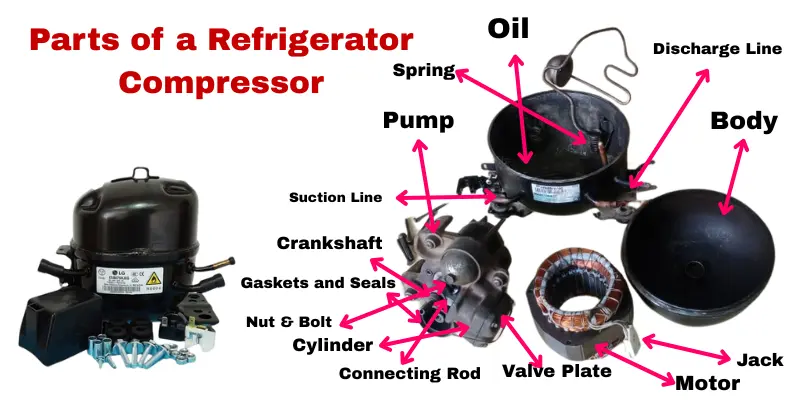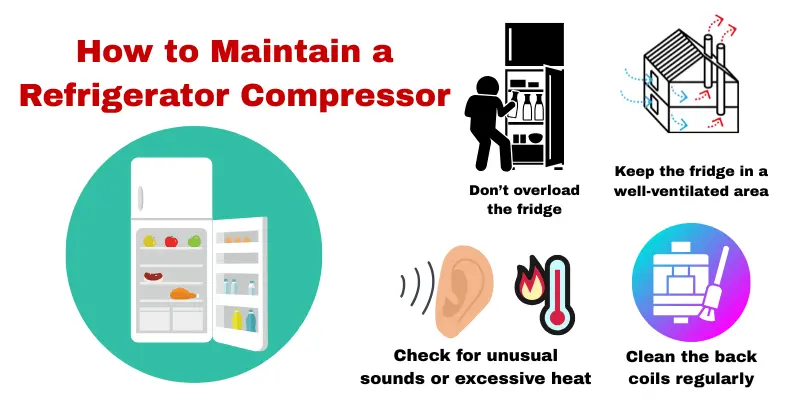What Is the Compressor of the Refrigerator? Explained Simply
Published: 1 Oct 2025
Have you ever wondered how your fridge stays cold all the time? Many people think it simply “creates” cold air, but that’s not true. The secret is the refrigerator’s compressor—the part that pushes heat out to keep everything cool. Without it, your fridge wouldn’t work properly, and your food wouldn’t stay fresh. But what is the compressor of the refrigerator, and why is it so important?
Let’s explore it step by step so you can understand how it works and why it matters. Keep reading to learn more!
What is a Compressor in a Refrigerator?
A compressor in a refrigerator is like a little helper that makes sure your fridge stays cold. It works like a pump, moving something called refrigerant through the refrigerator.

The compressor squeezes the refrigerant to make it very hot. Then, the hot refrigerant moves through pipes, cools down, and helps pull the heat out of the fridge. This keeps your food fresh and cold. Without the compressor, your fridge couldn’t keep things cold, and your food would spoil.
Importance of a Compressor in a Refrigerator
The compressor in a refrigerator is important because:
- It moves the refrigerant through the cooling system.
- It removes heat from inside the fridge, keeping your food cold.
- Without the compressor, the fridge wouldn’t be able to cool properly.
- It helps keep food fresh and prevents spoilage.
- The compressor ensures the refrigerator works efficiently, saving energy.
Now that we know what a compressor in a fridge is and why it’s so important, it’s time to discover something even more interesting—how it actually works! Have you ever wondered what happens inside your fridge to keep things cold? Get ready, because the next part will explain it in the easiest way possible. Are you ready? Let’s find out in the next section!
How Does a Refrigerator Compressor Work?
A refrigerator compressor helps keep the fridge cold by moving refrigerant through a cycle. Here’s how it works:
- Step 1: The compressor pulls in refrigerant gas from the fridge.
- Step 2: It squeezes the gas, making it hot and high-pressure.
- Step 3: The hot gas moves through the condenser coils at the back of the fridge.
- Step 4: The refrigerant cools down and turns into a liquid.
- Step 5: The liquid refrigerant moves to the evaporator coils inside the fridge.
- Step 6: It absorbs heat from the food and air, turning back into gas.
- Step 7: The compressor pulls in the gas again, and the cycle repeats.
This process happens over and over, keeping your fridge cool and your food fresh!
Parts of a Refrigerator Compressor
A refrigerator compressor may look small from the outside, but inside, it’s packed with important parts that all work together to keep your fridge cool. Each part plays a special role in moving and compressing the refrigerant, so your food stays fresh and chilled. Let’s take a look at the main parts inside a typical refrigerator compressor.

Main Parts of a Refrigerator Compressor
- Motor – Powers the compressor and keeps everything running smoothly.
- Pump – Helps push the refrigerant through the cooling system.
- Piston – Moves up and down to compress the refrigerant gas.
- Cylinder – The space where the piston moves inside the compressor.
- Crankshaft – Turns the piston’s up-and-down motion using rotating power.
- Connecting Rod – Links the piston to the crankshaft, helping it move.
- Valve Plate – Controls the flow of refrigerant into and out of the cylinder.
- Body (Housing) – The outer shell that protects all the inside parts.
- Oil – Keeps moving parts cool and lubricated, preventing damage.
- Suction Line – Where the refrigerant gas enters the compressor.
- Discharge Line – Where the high-pressure refrigerant gas exits the compressor.
- Gaskets and Seals – Keep everything airtight to stop leaks.
- Spring – Helps control the movement of the piston and valves, ensuring smooth operation.
- Nut & Bolt – Hold different parts of the compressor together securely.
- Jack (Compressor Terminal Pins) – The three electrical terminals (Common Running Starting Point) where the relay, overload protector, and capacitor are connected.
Types of Refrigerator Compressors
Not all refrigerators have the same type of compressor. Different compressors work in different ways to keep your fridge cool. Here are the main types:

- Reciprocating Compressor – Uses a piston to pump refrigerant and is common in household fridges.
- Rotary Compressor – Uses rotating blades for quieter and smoother cooling.
- Inverter Compressor – Adjusts speed based on cooling needs, saving energy.
- Scroll Compressor – Uses two spiral-shaped parts for efficient and quiet operation.
- Screw Compressor – Mostly used in large refrigeration systems for heavy cooling.
Each type has its benefits, but all help keep your fridge running efficiently!
If you want to know the details about all the types of refrigerator compressors, our guide is here.
Uses of Refrigerator Compressors
A refrigerator compressor is not just used in home fridges. It plays a key role in many cooling systems that keep food, medicine, and other products fresh. Here are some common applications:
- Home Refrigerators keep food and drinks cold in households.
- Commercial Refrigerators are used in grocery stores, restaurants, and hotels to store perishable goods.
- Industrial Refrigeration – Helps in large cold storage units and warehouses for food preservation.
- Medical & Pharmaceutical Storage – Keeps medicines, vaccines, and lab samples at the right temperature.
- Air Conditioning Systems – These are used in AC units to cool rooms and buildings.
- Transport Refrigeration – Found in refrigerated trucks and containers to transport fresh goods.
These applications show how important refrigerator compressors are in daily life and industries!
Advantages and Disadvantages of Refrigerator Compressors
A refrigerator compressor is essential for cooling, but like any machine, it has both benefits and drawbacks. Here are some key points:
| Pros |
|---|
|
Here we will discuss some of the disadvantages.
| Cons |
|---|
|
These points highlight both the strengths and challenges of refrigerator compressors!
Signs of a Faulty Compressor
If your fridge isn’t working properly, it might be because of the compressor. The compressor helps cool the fridge, so when it has problems, your fridge might not work properly. Here are some signs that your compressor could be faulty:
- Fridge is not cooling properly: If your fridge can’t keep your food cold, it could be because the compressor isn’t working well.
- Unusual loud noises: If you hear strange, loud sounds coming from the fridge, it could mean the compressor is having trouble.
- The compressor runs continuously or doesn’t start: If the compressor keeps running without stopping, or it doesn’t start at all, it’s a sign that something’s wrong.
- Energy bills are higher than usual: When the compressor is broken or not working well, your fridge may use more electricity, making your energy bills go up.
If you notice these signs, it’s a good idea to get your fridge checked. The compressor might need to be repaired or replaced!
How to Maintain a Refrigerator Compressor
To keep your fridge working well and your compressor in good shape, it’s important to take care of it. A little maintenance can help the compressor last longer and keep your food fresh. Here are some easy steps you can follow to take care of the compressor:

- Keep the fridge in a well-ventilated area: Make sure there’s enough space around your fridge so air can flow freely. This helps the compressor work properly.
- Clean the back coils regularly: Dust and dirt can build up on the coils, making the compressor work harder. Clean them once in a while to help your fridge stay efficient.
- Don’t overload the fridge: If you stuff your fridge with too many things, the compressor has to work extra hard to keep everything cool.
- Check for unusual sounds or excessive heat: If you hear strange noises or feel heat around the fridge, it could mean the compressor is stressed or damaged.
Taking these simple steps can help your fridge and compressor run smoothly for a long time. But don’t worry if you’re not sure what to do! In the next section, we’ve collected some common questions and answers about refrigerator compressors to help you out. Stay tuned to learn more!
Frequently Asked Questions About Refrigerator Compressors
In this section, we’ll answer some common questions that haven’t been covered in the article so far. These questions can help you dive deeper into understanding refrigerator compressors and their functions. Let’s explore them!
Here’s a list of questions that might arise as you learn more about how compressors work in refrigerators:
- What causes a refrigerator compressor to fail?
- How long does a refrigerator compressor usually last?
- Can a refrigerator compressor be repaired, or does it need to be replaced?
- Why is my refrigerator compressor so noisy?
- Is it possible to replace a refrigerator compressor by myself?
- Can a faulty compressor affect the food inside the fridge?
- What is the cost of replacing a refrigerator compressor?
- How can I tell if the compressor is working properly or not?
- Does the size of the compressor affect the fridge’s cooling performance?
- What are the environmental impacts of using refrigerator compressors?
These questions will help you understand everything about refrigerator compressors that wasn’t covered earlier. Keep reading to find the answers in the next section!
A refrigerator compressor can fail if it overheats, works harder than normal, or if one of its internal parts breaks. Poor ventilation around the fridge can also make the compressor overwork. Lack of regular cleaning and maintenance speeds up wear and tear. Over time, these issues can cause the compressor to stop functioning completely.
On average, a refrigerator compressor lasts about 10 to 15 years. With proper care, some can even last longer. Regular cleaning of the coils, avoiding overloading the fridge, and keeping good airflow all help extend its life. Taking care of small issues early also prevents the compressor from wearing out too quickly.
In some situations, a refrigerator compressor can be repaired if the damage is minor. A technician may be able to fix wiring or replace small parts. However, if the compressor has major damage or internal failure, replacement is usually the only option. Deciding between repair and replacement often depends on the cost and age of the fridge.
A noisy compressor may be a sign that it’s struggling to run properly or has been damaged. Sometimes the noise comes from loose parts or the buildup of dust and dirt around the motor. In other cases, it could point to more serious mechanical problems. If the noise is new or unusually loud, it’s best to have a technician check it before it fails.
Replacing a compressor is a complex job that requires special tools, refrigerant handling, and electrical knowledge. Attempting it without proper training can damage the fridge or even be unsafe. Because of this, most experts recommend calling a professional for compressor replacement. This ensures the repair is done correctly and keeps your warranty valid.
Yes, a faulty compressor directly affects how well the fridge cools. If it stops working properly, the temperature inside will rise, leading to spoiled food and drinks. Even slight compressor problems can cause uneven cooling, where some items stay cold while others don’t. This makes it important to repair or replace the compressor quickly.
The cost of replacing a refrigerator compressor depends on the brand, size, and where you live. On average, it can range from $200 to $700, including parts and labor. High-end or built-in refrigerators may cost even more to repair. Before replacing, it’s good to compare the cost with buying a new fridge, especially if the unit is old.
You can check your compressor by listening for unusual noises, feeling if it gets too hot, or noticing if it runs non-stop. If your fridge isn’t cooling well, it’s another sign the compressor may be failing. Sometimes the compressor clicks on and off frequently, which means it’s struggling. When in doubt, a technician can run proper tests to confirm the problem.
Yes, the compressor size plays a role in cooling performance. Larger fridges usually need bigger compressors to keep food at the right temperature. A smaller compressor may struggle if the fridge is overloaded or frequently opened. Matching the compressor size to the refrigerator design ensures efficient cooling and energy savings.
Refrigerator compressors use refrigerants, which can harm the environment if not handled or disposed of correctly. Older models often use refrigerants that contribute to ozone damage and global warming. Newer refrigerators are designed with eco-friendly refrigerants that are safer for the planet. Choosing energy-efficient models also reduces electricity use, lowering the overall environmental impact.
There may still be some doubts in your mind. So don’t worry! We have prepared a final conclusion paragraph for you as a bonus. Don’t forget to look at it. Let’s see in the next section.
Conclusion
So guys, in this article, we’ve covered what is the compressor of the refrigerator is in detail. Now that you know how important the compressor is for keeping your fridge cool, it’s a good idea to take care of it with regular maintenance. I recommend checking your fridge for any signs of wear and tear to keep it running smoothly. If you ever experience issues with your fridge, don’t hesitate to call a professional. Keep your compressor happy, and your food will stay fresh for a long time! For more helpful tips, stay tuned to our upcoming articles!
If you’re curious about the science behind how refrigerators work, check out our detailed guide on How Refrigerators Work. It’s packed with useful insights to help you understand your fridge even better!





